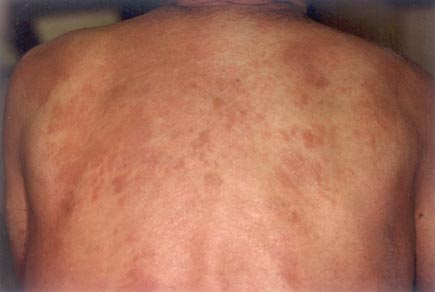MKSAP Quiz: 7-year history of plaques
A 48-year-old man is evaluated for a 7-year history of spreading plaques associated with dry, itchy skin. He has no other significant medical history and takes no medications.
On physical examination, vital signs are normal. Skin lesions are present on the arms, back, and legs. Representative skin findings on the back are shown.

There is no lymphadenopathy or hepatosplenomegaly. The remainder of the examination is unremarkable. Results of complete blood count and serum chemistry panel are normal.
Chest radiograph is normal. Skin biopsy reveals infiltration with CD4-positive T cells with cerebriform-appearing nuclei consistent with mycosis fungoides.
Which of the following is the most appropriate management?
A. Cyclophosphamide, doxorubicin, vincristine, and prednisone (CHOP) chemotherapy
B. Psoralen plus ultraviolet A (PUVA) therapy
C. Topical glucocorticoids
D. Rituximab
Answer and critique
The correct answer is C: Topical glucocorticoids. This question can be found in MKSAP 17 in the Hematology and Oncology section, item 118.
Topical glucocorticoids are most appropriate for this patient with mycosis fungoides, which is one form of cutaneous T-cell non-Hodgkin lymphoma. Lymphomas expressing T-cell surface antigens (CD4) are among the more common forms of cutaneous T-cell lymphomas. These antigens infiltrate skin and initially cause rash (mycosis fungoides) and, occasionally, also circulate in the blood (Sézary syndrome). The CD4-expressing malignant T cells are large and have classic “cerebriform”-appearing nuclei and clonal T-cell receptor gene rearrangements. Patients usually present with dry, pruritic, erythematous skin patches; mycosis fungoides confined to the skin can mimic these benign dermatologic conditions, and be undiagnosed for many years. Patients with progressive disease develop raised plaques, diffuse skin erythema, and cutaneous ulcers. In the final stages of progression, organ infiltration and evolving immunodeficiency cause recurrent bacterial infections, sepsis, and death.
Therapy is guided by disease stage. Early-stage disease (stages I and II) is limited to the skin, and patients have a median survival of over 20 years. Patients with early-stage disease are treated effectively with topical glucocorticoids. If there is no response to glucocorticoids, adding retinoids (such as bexarotene) and psoralen plus ultraviolet light (PUVA) therapy, at times combined with interferon alfa, may be effective. Patients with advanced disease (stages III and IV) have extensive skin and organ involvement and a median survival of 4 years. These patients require more aggressive therapy, including electron-beam radiation therapy; photopheresis; systemic therapy, including cyclophosphamide, doxorubicin, vincristine, and prednisone (CHOP) chemotherapy; histone deacetylase inhibitors (such as romidepsin and vorinostat); and monoclonal antibodies (such as alemtuzumab). Allogeneic hematopoietic stem cell transplantation may be curative in young patients who have advanced disease and an appropriate donor.
CHOP chemotherapy is indicated for patients with advanced disease, which this patient does not have due to absence of lymphadenopathy or organ involvement.
PUVA therapy may be effective for patients with early-stage disease who do not respond to topical glucocorticoids.
Monoclonal antibody therapy may be used in advanced stage mycosis fungoides using agents such as alemtuzumab, which is directed toward T cell surface proteins. Rituximab is a monoclonal antibody directed toward surface proteins typically found on immune system B cells and is not used in treatment of mycosis fungoides.
Key Point
- Patients with early-stage mycosis fungoides are treated initially with topical glucocorticoids; if glucocorticoids are ineffective, adding retinoids and psoralen and ultraviolet light therapy, sometimes combined with interferon alfa, may be effective.



